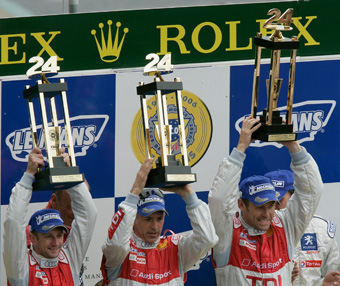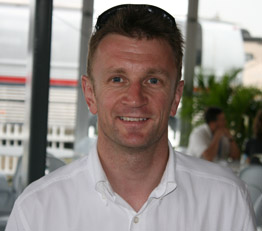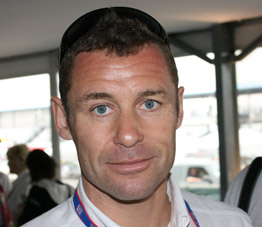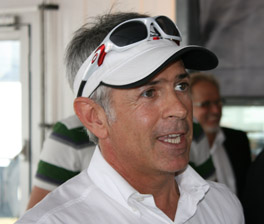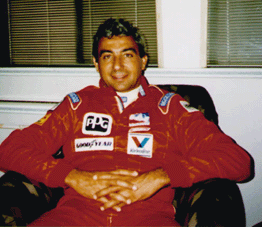
SARNI MOTORSPORTS INTERVIEWS
Michele Alboreto's teammates have tasted Victory at Le Mans, in part, due to his development work for Audi. Read what the winning drivers have to say about their friend and teammate, Michele Alboreto. The excerpts are from interviews to be published in a forthcoming book on the life of the Italian Racing Hero written by his brother Ermanno Alboreto and Greg Sarni.
Allan McNish
GS: You mentioned to me at Laguna Seca that Michele Alboreto endorsed your talent as a driver at a low point in your career. Do you feel like you owe somewhat of a debt of gratitude to him for that?
AM: I think Michele was a very honest person. And you’re right, he did, he stood up for me, spoke in my behalf and he had no reason to do that; and also within Audi as well. I remember one situation, now I won’t go into detail, but certainly I was out on a limb a little bit and he was the one that went to Dr. Ullrich and he fought my corner for me. At that moment, I appreciated Michele Alboreto deeply.
GS: How much of that endorsement would you say helped your career in the eyes of others, in particular, Dr. Ullrich and how much did it affect your confidence on a personal level?
AM: In terms of the confidence, it helped a lot because Michele was a legend when I was growing up. I remember watching him in Grand Prix and his career as well. We don’t need to go into the details of that, but also with regard to Dr. Ullrich, I think when anybody with his stature speaks positively about you, the other person listens and takes note. And if Michele Alboreto spoke or Wee Willie Johnson, from down the street spoke about Allan McNish, who would you listen to? In that respect it is difficult to quantify the benefit and the positive effect it had. But there’s no question about it; it was a massively positive event.
My racing with him in 2000, we finished a very close second here (Sebring) and also a couple of other races that I did with Michele and winning at Petit in 2000 as well. I learned a heck of a lot of how to drive a racing car and learned a heck a lot of how to be a gentleman.
GS: Now did you learn by watching or did he offer up tips on techniques to you personally or did you just observe?
AM: Observe and listening to someone with an open book philosophy.
GS: One of the last times I interviewed you was in Adelaide right before you joined F1, after having a taste of Formula 1 and everything that goes with it, do you feel fortunate to have ended up back with Audi driving Sports Cars?
AM: I kinda always knew that when I was done with Formula 1 that I would end up back here. It was never written down, but I was keen for it to happen and uh, pleased that Dr. Ullrich was keen for it to happen. It’s funny because Formula 1 was a very, very big lesson; that the haves and the have nots are so far apart there. And if you’re in a have not situation, then you haven’t got a hope in Hell. And that’s why I prefer to be with a team like Audi that when you go into a race you know you’ve got a chance of winning. You know you have a chance at success instead of circulating in a Formula 1 grid.
GS: Getting back to that, Michele, when he was competing in Indy cars in America remarked to me how refreshing it was to be able to operate without all the distractions of the F1 circus, that it was like it was when he first started in F1. You’re certainly qualified to make comparisons. How would you relate the World Circuit with driving in America in the ALMS?
AM: I feel like I’ve got a big smile and a light heart when I come to race here. The pressure and the tension is from the focus to win. Whereas in Formula 1 there’s so many outside influences that are attacking ya that you don’t know about that I think bring on a lot of unnecessary pressures and stress. This is what it’s all about, this is raw, it’s real and I would say, excuse the French, but there’s very little Bullshit here. And that’s something that I think every driver that’s been in Formula 1 and then gone outside realizes, you know, the enjoyment, the actual pure enjoyment of racing.
Tom Kristensen
GS: Tom, you paired with Michele in 97 in a Porsche to win Le Mans. How well did you know Michele before becoming his teammate?
TK: I didn’t know him personally before I became his teammate. But I can say the way that I came to the team, only a few days before the actual race with him and Johansson.
He was very, very good at giving me confidence. I was leading the Formula 3000 Championship and I was then assigned as a young driver to get experience. And he gave me a lot of confidence, he didn’t tell me what to do, but I asked him a lot. And he taught me a lot about, let’s say not taught, let’s say, he explained to me a lot of things what I had to do, how to do it, but only because I asked him. He was not the guy who pushed you or said, Tom listen, no not at all. He was very generous with that and was extremely an extremely, eh, great, great man. Extremely gentle. Always really resting within himself. Nice personality; always caring.
So, of course after that further on when we drove with Audi as colleagues; not in the same car, but as colleagues with Audi as well. But that first year, it gave me lot, because basically it kick started my career. Because we went on to win Le Mans and I went a few tenths faster than him in the race to make the lap record. So in my debut win at Le Mans and also with a lap record during that year. It owes a lot to him and being with a team like Joest. He was very, very calm and a nice, nice man.
GS: What did you think Michele’s best attribute as a driver was?
TK: I knew him as I said from only late in his career, but as a driver, I mean, pffft, this you had better you ask somebody else, because this is not what I would give. I would give you, as a human being, as being on a team with him, he was obviously; his technical feedback was very good. But I would say that he would be at the very top of the list if you would go to racing drivers who is caring and humble and not selfish.
GS: I’m hearing that from a lot of people.
TK: All of these things, he would be at the very top of the list. He is, what do you call it? I don’t know what you call it? What do you call it? Like a figurehead, for a lot of people that knew him. A lot of people who knew him, would put him as a figurehead for how you should behave off the track for being a nice gentleman and I don’t know anyone who doesn’t say that they absolutely, ah love him.
Dindo Capello
GS: Do you remember the first time you met Michele Alboreto?
DC: Yuh, I will never forget, because I was almost 18 then. A guy, trying to find a way to race a car and I was in Milano walking down from an office from a guy who was involved in Motorsports and a friend of mine suggest me to talk with this guy to get some advice how to start, with which car…
GS: What was his name?
DC It was Simone Vullo, Mario Simone Vullo, He was, I know, like eh, not manager, a best friend of Michele and stepping down, coming out of his office, I just met on the stairs Michele and I remember that he was just coming from Brazil from probably his very first Formula 1 test and he was, I remember, really, he had a really strong sun tan. And when I recognized him, (Jesus, Jesus Michele Alboreto!) and he was…
GS: A big hero in Italy?
DC: Yuh, yuh, but this was in the beginning.
GS: But you knew who he was.
DC: For me he already was a big hero. And then, when it was 1982 and then when, almost twenty years later, seventeen years later, I race in Sebring with him and Stefan Johansson, that was my first Sebring race and that was like being in a dream.
GS: I’ve heard from others about his friendly generous spirit, did he help you in any way?
DC: As soon as Michele join us in Audi, immediately, we built a very strong friendship. And since that moment, we were always traveling together in one car and we get really a strong relationship in and out of the racetrack, I get very close to his family as well and I still close to his family, his wife and his daughters and Ermanno. Ermanno, you know, was racing in Formula Abarth in ’83 and we were competitors together.
But really surprised me with Michele; even if he was the most famous Italian driver and I think still he is the most famous Italian driver, he was so nice and so open, that I could not believe that meeting him that such a famous people could be so nice.
Michele Alboreto
Please note that the interview was trancribed as is, broken English and all!
Read or LISTEN to the Alboreto interview
GS: Welcome to New Hampshire.
MA: Thank you.
GS: You've had a long and storied career in Formula One and Sports Cars and now oval track racing. Could you compare the different driving techniques that you use in an open wheel car on an oval to let's say, the World Sports Car Ferrari 333SP?
MA: Ah, first of all it is a monoplaste, so the limit of the car on an oval is much higher than the one of sports car. The sports car is made for long distance racing so everything is building up to resist, even 24 hours, like in Daytona, like in Le Mans. The oval car is made to be very quick for a short time, so everything is on the limit, the suspension and the aerodynamics and everything. So the limit of the monoplaste is much higher. But it is much more difficult also to drive!
GS: Do you feel like you are starting all over again in racing with the learning curve you have to face in oval racing?
MA: Ah, yuh exactly, I start again because if you think and you came here with everything new already, you make a big disaster. So it is better to, be quiet and start like, no strange things in the mind and be careful what everything you do.
GS: Do you think that the pressure to win here in the IRL is as intense as it was in Formula 1 on you personally?
MA: Every race is, even in the club historical racing, for professionals cars there is competition. When there is competition, everybodys come here to win. So the pressures to win is the same. Probably here, the ambience is much quieter. In Formula 1 there is too many distractions, people and ah, here I feel much comfortable.
GS: That was my next question, do you feel that race weekend is more relaxed in the states?
MS: Yes, I tell you, I feel like my beginning in Formula 1. In the beginning of my career in Formula 1, it was much like this. Everybody see each other under the tent, in the motor home and everything. My last season in Formula1, everyone, they close the motor home, just see each other sometimes in the debriefing and then the drivers are never together.
GS: Even amongst the drivers?
MA: Ah yuh, the ambience right now is like my beginning in Formula 1.
GS: And that is more because Formula 1 has changed and not because you grew up the ladder.
MA: Too much media, too much sponsors, too much money, too much people involved.
GS: And that equals pressure, too.
MA: Yuh.
GS: But the pressure to win, for you, comes from within.
MA: When you put your helmet on, and you go, the pressure to win is the same.
GS: Speaking of helmets, you have one of the most recognizable helmets in motorsports, I understand it is a tribute to someone that you admired, Ronnie Peterson?
MA: Yes, it was my, good friend and ah, it was my, fellow driver when I was young. So when I decided to start my career, I decided to keep the Swedish colors, that is why.
GS: As a tribute to him?
MA: Yes.
GS: You've raced against some of motor racing's finest in Mansell, Prost and Senna
MA: Lauda, Piquet, Reutemann, Fittipaldi, Mario Andretti
GS: Right! Unbeliveable.
MA: Nelson Piquet, I have a lot of good remebering, Niki Lauda too.
GS: Can you tell us something about what it was like competing against the three time Champion from Brazil, Ayrton Senna?
MA: Well, the story between me and Ayrton, because we arrive in Formula 1, more or less at the same moment, we grow up as two young aggressive drivers and at the beginning of our career, we have a big fight. Very big fight. Uh, I remember two or three times when we was very, very close to hava big, big crashes, but we push out each other two or three times, uh, in a very bad way. Mr. Ferrari call us and says both of us, "Remember that sooner or later you could be teammates so I want, now you shake your hands and stop these things." Because, was already for two or three races we push out each other.
GS: And so Enzo played the peacemaker.
MA: Yes, because he was supposed to have both of us on team, sooner or later. So, he was a really good, good fan of Ayrton and uh, we shaked hands and we became a friend from that moment. And uh, after that everything was much easier, he calmed down, I calmed down and we have a different career in the end. Because when I left Ferrari, unfortunately, I didn't have the chance to have a competitive car anymore, but Ayrton went on to have a fantastic career and was my, favorite guy because he was very clever, very serious. I don't think that now, even that Schumacher can - I'm not talking about the driving point of view, but as a person, it is difficult to be like Ayrton was.
GS: Very intense individual.
MA: Yuh and he takes care about safety, he can put himself on the weight, to defend all of the drivers. And I don't see that from the drivers that is in Formula 1 today. And remember that Ayrton, was one of the little guys that, uh, defend even the last guy on the field. Because, you know that when you are famous in Formula 1, that you can do everything that you want, but when you pay to drive, they can, they can, fire you in five minutes. So he says, "If these guys doesn't drive, I don't drive too." So, he tried to have the association of the drivers in Formula 1 close together. I don't see that after him, after him everybody thinks about themself. And that's bad.
GS: I think that a lot of the tifosi in your home country would have liked to have seen Senna in a Ferrari at one point and that never came to pass.
MA: Well, we was very close to have Ayrton in the Ferrari in '87 and then the budget for Ferrari doesn't, uh, permitted that. He was close to sign again in a '91or '92 and then uh, they postpone this things another year. But I'm sure that if he was alive today, he would be driving a Ferrari.
GS: And one more thing, uh, we'd just like to have you tell the radio audience; what type of motorcycle do you ride Michele Alboreto?
MA: Ah, I was ah, glad to see you on a Ducati F1, because it is the same type bike that I have, to enjoy on the track, but I have also, two Harley-Davidson.
GS: Laughter, ahhh! But the 750 F1 is...
MA: Is a racing bike, so is a super bike from ten years ago.
GS: Exactly.
MA: And a very famous bike in Italy, but is a little bit too quick for the road, so for the road, I prefer to use my Harley Davidson.
GS: Well, to meet you up here on this interview I used that quickness to make it here on time!
MA: Laughter
GS: Thank you very much and good luck this weekend.
MA: Thank you.
A Brief Note From Greg Sarni
Michele Alboreto died in a testing crash in Germany. Although it is difficult for me right now to find the motivation to share this passion, I find solace in celebrating what a terrific individual Michele Alboreto was as a human being. He was the last Italian born race driver that Enzo Ferrari chose to drive his Formula 1 car.
When his arch rival, Ayrton Senna, died in the Gran Prix of San Marino, he was a credible witness in court that it was equipment failure and not driver error that led to the crash that killed Senna. He did this out of respect for his fellow driver and to preserve the 3-time World Champion's honor as a talent without peer. An investigation into Alboreto's crash has found that a puncture of the left rear tire of his Audi R8 caused the blowout which caused the Audi to veer right and become airborne at 200 mph.
He had every right to be an arrogant, unapproachable, millionaire race driver. He was quite the opposite. When I interviewed him in '96, when he was driving in the Indy Racing League, many would have been too proud to compete in a series considered to be inferior to F1. Michele didn't care, he just loved to drive and compete.
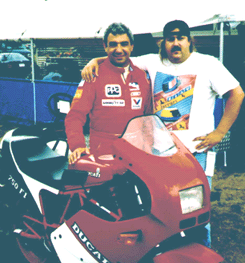
I'm glad that I met him, because his life, the way he lived it and left it, taught me something. I learned that it is important to do what makes you happy, to treat others with kindness and compassion and to enjoy yourself. Life is short, so have fun and do your best to make a difference in the the lives of everyone you meet.
Michele's teammate, Emanuele Pirro penned a touching goodbye.
We all know that our sport is dangerous and we all know that anything can happen at anytime. We all should be prepared for the worst but when something happens, you realize that you are not prepared at all.
Loosing an outstanding driver, a friend for 20 years and your teammate at the same time is harder that I thought it would be.
Michele was a real gentleman and those who had the pleasure of meeting him know what I mean. I think of his family, his wife Nadia, their two daughters Noemi and Alice, alone with their sadness and their memories and I send them my deepest sympathy.
We are in shock today. I spoke to Frank Biela, Dindo Capello, Dr. Ullrich, some of the Audi Sport and Joest people and a lot of common friends.The phone keeps ringing all the time, and our sadness is immense.
A famous person of the past said: "In motor racing, no driver is too good to die" This is a bitter truth that applied to Michele, too.
I believe we, racing drivers, are blessed people who received a gift from God. We are doing something that we love with all of our hearts and we have a wonderful and intense life. Sometimes, unfortunately, life is not long enough, but none of us would like to trade it with anything else.
Michele has taken a part of all of us with him, but a lot nice memories remain.
Emanuele
Alan Wilson CEO Track Manager and Designer of Miller Motorsports Park
GS: Thanks for taking the time to speak with us; I’m sure it’s pretty busy there right now.
AW: Sure, yuh, all of the transporters are rolling into the paddock and setting up right now.
GS: Didn’t you have Gil de Ferran there earlier in the week getting going with his testing?
AW: We had him last week and Monday, Tuesday testing on the track, yes?
GS: This will be his first race in the Acura, I believe.
AW: I believe so.
GS: You’ve had a great career in racing, beginning in your native South Africa with Ford Motors. You were responsible for overseeing Formula 1 Grand Prixs in England, the 24 Hours of Daytona endurance race, CART races and International motorcycle events. I believe you’ve also served in management positions of several sanctioning bodies. In fact, I understand that – and I’m a little jealous of this – that you have visited over 175 race facilities!
AW: I think the figure is closer to 200. I just haven’t counted for about a dozen years.
GS: To me, that would be paradise! When you design a race track, do you try to embody some of the attributes of your favorite tracks into your work or are you looking for something that has never been done?
AW: Probably everything’s been done, but no I don’t deliberately try and put in something from the previous track as a matter of course. There is a corner here at Miller Motorsports Park that I have finessed from other tracks and funny enough, it’s very similar to turn 8 at Turkey, a little bit slower.
GS: Oh, that four apex turn there?
AW: This is a three apex turn; it’s a favorite on our track.
GS: That sounds like fun right there. How many track have you designed?
AW: I’ve designed over 50, of which 29 have been built.
GS: I understand that you designed the club track in New Hampshire, what’s the status of that project?
AW: You know, I currently don’t know. I haven’t heard from them for a while. What happens is I’ll design the track, get involved in the beginning of the process and then they go away and get it funded and get the permitting done. When they’ve finished with that they call me back in to finish the design. So, as far as I know that’s the status. But this is a particularly difficult one to get through the environmental planning. So I don’t know quite where it stands.
GS: I think that environmental hurdle is one that you face many times when you design tracks; don’t you?
AW: Every single track. It’s a fact that we have to live with and um, obviously we’ve done it many times, but there are many tracks that also have not got through because they couldn’t get through the environmental process.
GS: You have designed a state of the art facility there in Utah that hosts two important events this month, starting with the American Le Mans Series race this weekend and the return of World Superbikes at month’s end. What is your mood when the racing world focuses in on one of your creations?
AW: Pride. And concern. Pride because, um, maybe I’m lucky, but there seems to be a lot of positive comments coming out of people; particularly leading up to this ALMS race. Because, we switched them from the full track, which was four and a half miles, to a 3.08 mile track, which is a lot faster and this seems to suit the top end cars. So, you know people from Gil de Ferran to Johnny O’Connell to Adrian Fernandez, but a bunch of them are pretty high in their praises of the facility. Which obviously makes me feel good, but at the same time, at any event I’m concerned, because I don’t want people to have accidents, I certainly don’t want people to get hurt. So I’m sort of on pins or hooks throughout an event.
GS: When they were racing on the long course, I understand some of the guys felt like they were sort of getting lost out there it was so long, they didn’t know where they were on the track and it took them a long time to learn it I understand.
AW: Yuh. But you know, that’s what Road Race drivers do, they learn tracks and it’s is a longer track. Imagine the same guys running the Targa Florio? If they complain about learning four and a half miles in the dessert, thirty five or forty miles in the mountains would scare the Hell out of them!
GS: Or the Nordscleife in Germany, right?
.AW: Yuh!
GS: Our intention of speaking with you today is to convince people to attend a race at Miller Motorsports Park. Some of us, who travel around the world in search of our next motoring experience, also have to sell that prospect to our partners. What other attractions, in addition to racing at Miller, does the Salt Lake City area have to offer visitors?
AW: Well obviously, we’re a mountain state and there’s still a lot of snow in the mountains so it’s very pretty. Park City is only 40 minutes from Salt Lake; it’s about 50 minutes from where we are. You know, Salt Lake is a neat place to be, it’s very convenient, the airport is only 10 minutes from downtown, and the track is only 20 minutes from the airport. So, it’s a very convenient facility, very well located. Downtown is a neat place. This is where the Olympics were, the city came to life for the Olympics and never gone back to sleep.
GS: I can personally attest to the fact that it’s beautiful. In High School I visited the area to meet relatives. My ancestors from Cambridge, Vermont actually went West with Joseph Smith to settle Utah. It really is a beautiful part of the country, I encourage people to get out there and see something different.
AW: Moab and places like that; yuh ya know it’s a days trip, two days trip, but if somebody comes in and decides to go down there, that is spectacular.
GS: I understand that’s a Mecca for mountain bikers and hikers and people who enjoy nature. And there’s Bryce Canyon and Zion National Park those are also beautiful.
AW: Utah has to be one of the best states in the country for just getting in the car and touring.
GS: I think it’s fairly undiscovered too, people usually don’t put it on their map, but they should for sure, it’s beautiful there. You have rubbed elbows with many greats in Motorsports. Is it possible for you to give us your top five racers in cars and motor bikes? Not necessarily the most talented, your favorites for their combined personalities and their achievements on the track as well.
AW: In cars, I never met Jimmy Clark, but obviously to me he was a super hero. Stirling Moss, I know him fairly well, he raced with my wife and he’s right at the top because he’s not only a brilliant driver, but he’s a gentleman and you know he’s the last of the old school. Mario I know Mario pretty well. Mario can be a bit crusty, but he is an unbelievable race driver
GS: Once you get beyond that veneer, yuh, he is a nice guy.
AW: If you wanted to write a dictionary definition of a race driver you just need to say, MARIO. You don’t even have to say his last name.
GS: Exactly.
AW: Alain de Cadenet; even though he’s not a world famous guy. He is the epitome of the Gentleman Racer who did very well when he was racing. He and my wife won two World Championship races together; endurance races. He’s just the character that racing used to be. Fun, devil may care and get out and do it. He’s not a name that most people would put at the list, but you asked not for the best race drivers, but some of my characters.
GS: We know him now from hosting the Designed to Win series on Speed Channel.
AW: Get him around the table and he’s one of the funniest guys you’ll ever meet, because he’s got stories, you know, coming out of the kazoom. He’s hilarious.
On the bike side, Freddie Spencer, Eddie Lawson, Obviously, right at the top, by a long way, Mike Hailwood and I did have the pleasure of meeting him a long time ago. There’s no one like Mike. Mike was the best motorcycle rider there’s ever been. I can’t imagine anyone being better then him. As good as Valentino Rossi is, Mike was the best.
GS: How does Agostini stand with you?
AW: Agostini, to me was clinical, he was very good. But remember, he always seemed to ride the best bikes. Now again, I’ve met Agostini and spent a little bit of time with him, he’s a nice guy and I can’t not respect him, but no, he wasn’t the Mike Hailwood, ‘cause Mike Hailwood was the character on and off the bike. To me racing is about characters and Ago is a God, yes, but Mike was super, he was way up top there.
Eddie Lawson, I’ve got a lot of respect for Eddie I think he was down to Earth. There was a period in racing when Wayne Rainey and Kevin Schwantz and Eddie and that bunch and Kenny Roberts, they dominated and quite rightly so, they were the best.
GS: Absolutely. Eddie Lawson was another one of those who made an attempt to go on after bikes and have a career in cars.
AW: I actually got very angry at the way Indy Car treated Eddie. Because here was a World Champion who was a superstar, he was basically made to buy his way into the paddock. He wasn’t respected by the Indy Car teams; they looked down on him he could easily have been a top Indy Car driver. Absolutely!
GS: It’s all about equipment isn’t it?
AW: Being put in the right car, if he had been put in a front running car, he could within a couple of years, because there was a learning curve, been very successful.
GS: Thanks very much for speaking with us Alan. We remind everyone to catch the American Le Mans Series and HANNspree Superbike World Championship races from Miller Motorsports Park.
